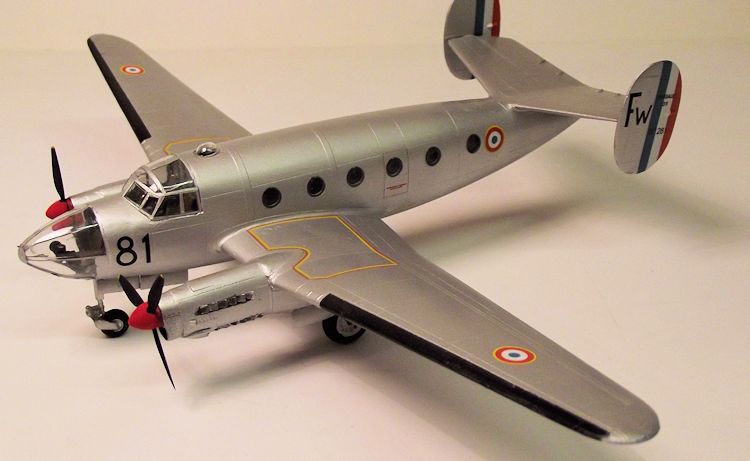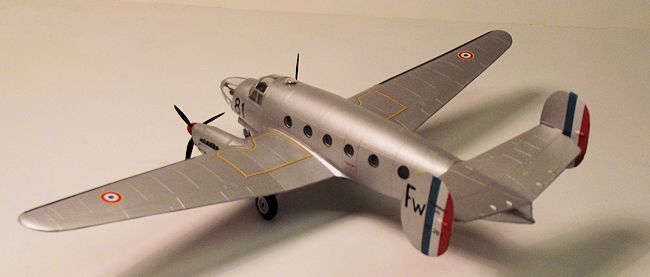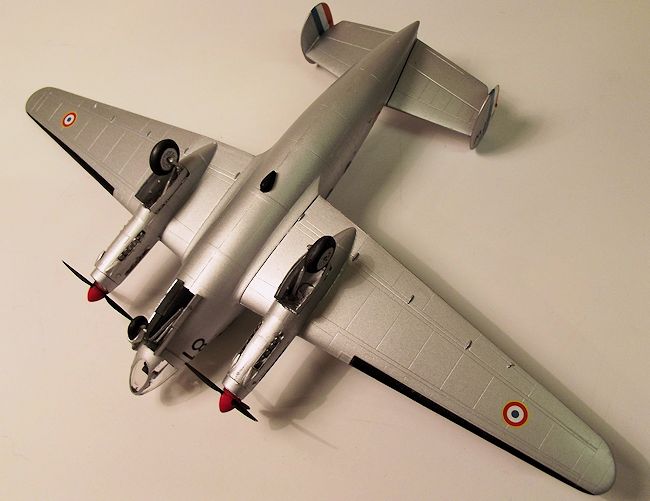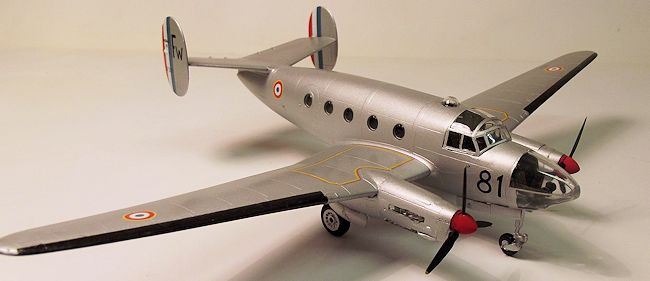
| KIT #: | A087 |
| PRICE: | £22.00 |
| DECALS: | Three options |
| REVIEWER: | Frank Reynolds |
| NOTES: | Good quality short run kit |

| HISTORY |
The Dassault Flamant ( Flamingo) is a
typical European military light transport of the 1950s, built in three versions
as the MD-311 trainer, MD-312 6-passenger liaison and transport version and
MD-315 general purpose variant for use in France’s overseas territories. It was
the first product of the newly named
 Dassault Aviation factory and flew in July
1946, being one of the first new types to come from a resurgent French aircraft
industry that was recovering from World War 2. Of the 318 Flamants built, 39
were the MD-311 crew trainer variant, ten of which were converted to a counter
insurgency role, fitted with six underwing SS-11 wire guided air to ground
missiles. Production Flamants were
powered by versions of the Renault/SNECMA 12S
580hp engine – a variant of the German Argus AS410 engines that had been
built in France during Nazi occupation
Dassault Aviation factory and flew in July
1946, being one of the first new types to come from a resurgent French aircraft
industry that was recovering from World War 2. Of the 318 Flamants built, 39
were the MD-311 crew trainer variant, ten of which were converted to a counter
insurgency role, fitted with six underwing SS-11 wire guided air to ground
missiles. Production Flamants were
powered by versions of the Renault/SNECMA 12S
580hp engine – a variant of the German Argus AS410 engines that had been
built in France during Nazi occupation
The primary users of the Flamants were France’s Armee de l’Air and l’Aeronavale
and small numbers were supplied to air arms within the French sphere of
influence in Vietnam, Cambodia, Tunisia, Madagascar and Cameroon. They gave long
and useful service in support roles and the last examples were retired from
French service in 1982.
| THE KIT |
Contained in a stout tray type box, there are three frames of parts in a
slightly soft medium grey plastic. These provide the main airframe components in
80 parts. Parts marked not for use include two alternative solid noses relevant
to other boxings of this kit. The parts are neatly moulded with no obvious
flash, although, as with most short run kits, the joining faces benefit from
light attention with as sanding
 stick.
stick.
There is a bag of crisply cast cream resin parts, forming the engine fronts,
exhausts and optional underwing pylons and missiles. One frame of clear parts
provides the nose and cockpit transparencies and round cabin windows. A small
etched fret and film provides the cockpit instrument panel.
All of the parts and accessories are separately bagged to keep the contents
safe. The box proclaims that the kit has “Design and conception in France.
Tooling and molding in Czech Republic” and bears the name and address of MPM
Models of Prague. So it has the
general air of a Special Hobby/MPM kit and is none the worse for that.
The instructions consist of simple exploded views in grey scale. They are rather vague in some areas particularly in regard to the location of internal parts such as bulkheads and undercarriage legs, so a careful study, much dry fitting and double checking is advisable before committing glue to the parts.
| CONSTRUCTION |
This begins with the cockpit, that consists of two side by side pilots’ seats
separated by a central console and a large bulkhead that closes off the rear
fuselage. I picked out the seat cushions in dark green and small details in
black. A full instrument panel is provided in unpainted etch metal.
 The rear cabin is bare, except for a long flat floor and since little is likely
to be seen through the windows I omitted this part so as to reduce weight behind
the pivot point of the main undercarriage. The interior was painted in Tamiya
XF-82 Ocean Grey. The plastic parts of the kit seem to cover all versions of the
Flamant and the characteristic glazed nose of the MD-311 is built up by a series
of add-ons and inserts, a method that challenges the tool making skills of the
likes of Hasegawa and Tamiya and no less the toolmakers in this case. A plastic
instrument panel and coaming close off the front of the cockpit, but the angled
sections to the front edges of the windscreen are formed from a resin section.
Forward of this the lower nose is filled with a projecting box that also forms
the nose wheel bay. This is surrounded by a horseshoe-shaped plastic section
that extends the nose forward, finished off with a clear plastic nose cone. So
including the canopy there are five add on sections to form the nose area.
The rear cabin is bare, except for a long flat floor and since little is likely
to be seen through the windows I omitted this part so as to reduce weight behind
the pivot point of the main undercarriage. The interior was painted in Tamiya
XF-82 Ocean Grey. The plastic parts of the kit seem to cover all versions of the
Flamant and the characteristic glazed nose of the MD-311 is built up by a series
of add-ons and inserts, a method that challenges the tool making skills of the
likes of Hasegawa and Tamiya and no less the toolmakers in this case. A plastic
instrument panel and coaming close off the front of the cockpit, but the angled
sections to the front edges of the windscreen are formed from a resin section.
Forward of this the lower nose is filled with a projecting box that also forms
the nose wheel bay. This is surrounded by a horseshoe-shaped plastic section
that extends the nose forward, finished off with a clear plastic nose cone. So
including the canopy there are five add on sections to form the nose area.
I found it best to extend the nose forward in progressive sections, each being
carefully aligned and left to set hard before proceeding with the next. As with
many short run kits there are no locating pins on any of the parts so very
careful alignment is needed. I find that slower setting glues, both cyano and
polystyrene, to be useful in this case, allowing some time to adjust parts
before the glue grabs. In spite of this, I ended up with some misalignment of
the forward fuselage structure and some filler was needed around the joints. The
clear parts were left until late in the build, permitting some nose weight (shot
gun pellets) to be slipped
 into the small underfloor spaces either side of the
nose wheel bay.
into the small underfloor spaces either side of the
nose wheel bay.
The wing assembly is conventionally split onto upper and lower sections, left
and right wing halves and the slim engine nacelles formed as two vertically
split halves. Separate engine fronts are delicately cast in cream resin and this
provided the opportunity to pack the front of the nacelles with even more weight
before the fronts were secured with cyano glue.
The tail section consists of upper and lower halves that fit securely onto the
rear fuselage and the prominent end plate fins are each moulded in one piece.
I found this to be a reasonably well engineered kit with a
generally good fit of parts, aside from
the touches of filler needed around
the various nose panels.
The weakest feature is the undercarriage. The parts are reasonably well defined but potentially fragile. The nose leg has a separately moulded wheel fork that is joined to the leg above by a small butt joint that has to bear the considerable pressure of the weighted nose. The parts were left to harden over a couple of days before the joint was strengthened with a smear of epoxy resin.
| COLORS & MARKINGS |
All four choices were of silver painted
airframes, so the whole aircraft was sprayed in Tamiya XF-16 Flat Aluminium and
the wing leading edges picked out in X-18 Semi Gloss Black.
Left to settle overnight the whole airframe was then rubbed down with an ultra
fine sanding stick and then brush finished with two coats of Future/Klear.
 The simple decal sheet has little in the way of airframe stencilling, but
provides national insignia, rudder striping and unit code letters for a choice
of three aircraft, two of which carry Orange trainer bands to wings and
fuselage. First is the COIN version, based at El Ablod, Algiers in 1959; the
second is from Dijon, 1963-4; the
third based in Toulouse 1969-70.
The simple decal sheet has little in the way of airframe stencilling, but
provides national insignia, rudder striping and unit code letters for a choice
of three aircraft, two of which carry Orange trainer bands to wings and
fuselage. First is the COIN version, based at El Ablod, Algiers in 1959; the
second is from Dijon, 1963-4; the
third based in Toulouse 1969-70.
The decals went on with little fuss and responded well to Micro Sol and Set.
When the decals had dried out the airframe was then finished with a sprayed coat
of Xtracrylic Semi-Gloss varnish.
The undercarriage legs fit into defined recesses in the wheel wells and are
straightforward to fix. Then it was just a case of adding the wheel doors and
aerials. With the nose area and engine nacelles packed with shot weights, the
Flamant balanced on its nosewheel – but only just, and at the slightest touch it
will tip over into a tail sitter.
| CONCLUSIONS |
Once again Azur provides a reasonable package. Since some of the airframe parts
are cast in resin, the Flamant is a good second or third attempt at a short run
kit, requiring more than just routine assembly, but not hopelessly complicated.
It is an unusual subject not readily available elsewhere.
| REFERENCES |
The kit instruction sheet.
Air Enthusiast Quarterly No. 49,
Key Publishing, February 1993
March 2014
If you would like your product reviewed fairly and fairly quickly, please contact the editor or see other details in the Note to Contributors.